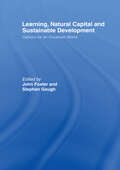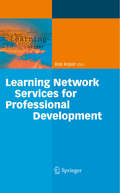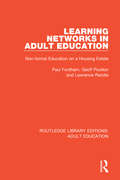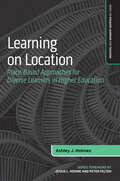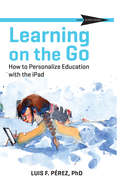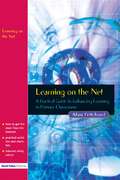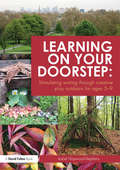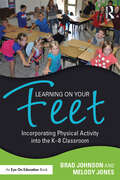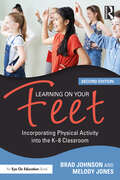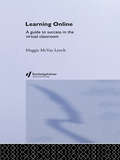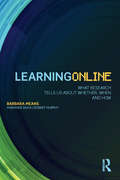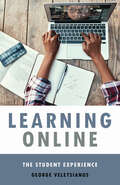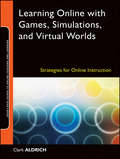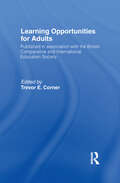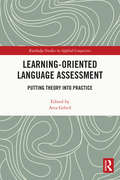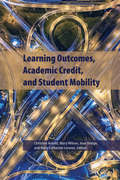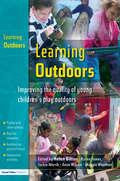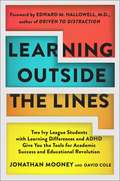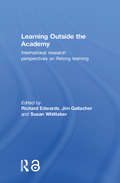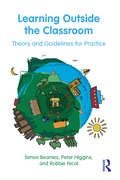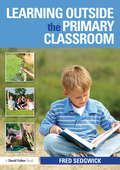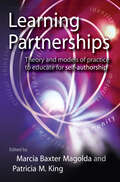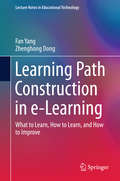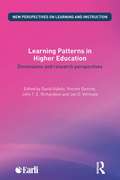- Table View
- List View
Learning, Natural Capital and Sustainable Development: Options for an Uncertain World
by John Foster Stephen GoughThis special issue of the journal Environmental Education Research addresses a topical area of importance - human behaviour towards the environment. The book explores the economic metaphor of 'natural capital' in this context arguing that the currently dominant model of sustainable development, underpinned by a particular understanding of this metaphor, is impeding progress towards genuine sustainability, and secondly that it will continue to do so until the metaphor can be reworked in both thought and practice.This book explores an alternative economic model of natural capital value, based on recent 'real options' thinking which reworks the natural capital idea and provides a framework for articulating two major and closely-related shifts of emphasis.
Learning Network Services for Professional Development
by Rob KoperA "Learning Network" is a community of people who help each other to better understand and handle certain events and concepts in work or life. As a result - and sometimes also as an aim - participating in learning networks stimulates personal development, a better understanding of concepts and events, career development, and employability. "Learning Network Services" are Web services that are designed to facilitate the creation of distributed Learning Networks and to support the participants with various functions for knowledge exchange, social interaction, assessment and competence development in an effective way. The book presents state-of-the-art insights into the field of Learning Networks and Web-based services which can facilitate all kinds of processes within these networks.
Learning Networks in Adult Education: Non-formal Education on a Housing Estate (Routledge Library Editions: Adult Education)
by Paul Fordham Geoff Poulton Lawrence RandleOriginally published in 1979, this book reports on a 3 year action research programme (The New Communities Project) which aimed in increase working-class participation in adult education. Basing their argument on the work of the Project, the authors contend that adult education must begin with the people themselves, to go on and assist their intellectual, social, psychological, cultural and political growth. In their view, adult education needs to be identified as something more flexible than 'classes', whilst also distinguishing between non-formal education and other kinds of community work or development. Providing different perspectives on the way in which a service relates to a particular area, the book's conclusions have a bearing on both practice and training in a variety of areas concerned with social intervention.
Learning on Location: Place-Based Approaches for Diverse Learners in Higher Education (Series on Engaged Learning and Teaching)
by Ashley J. HolmesThis book offers an innovative framework and set of pedagogical pathways for deepening college student learning through critical engagement with place. Though the what and how of teaching and learning rightly take center stage in research of best practices, this book argues that the where of education deserves increased attention. Drawing from interviews and case studies with college and university educators in the United States and Canada, Learning on Location highlights pedagogies-in-action and identifies programmatic models for embedding location-based learning within specific courses, majors, curricula, and campus-wide initiatives. Chapters provide a mix of theoretical framing and practical application, with three key practices grounding the text: writing on location, walking on location, and engaging the civic on location. This resource is an invaluable guide for higher education faculty, leaders, and practitioners seeking to enhance student experience through attention to location, support identity-conscious student success, and use reflection and praxis to move toward more inclusive and equitable learning experiences. Supplemental resources—including example assignments, discussion questions for reading groups, and more—are available at www.centerforengagedlearning.org/books/learning-on-location.
Learning on the Go: How to Personalize Education with the iPad (CAST Skinny Books)
by Luis F. PerezThe iPad is a powerful educational device—versatile, mobile, flexible, and accessible to all learners, including those with disabilities. A huge number of up-to-date applications exponentially lift its value as a teaching and learning tool. In Learning on the Go: How to Personalize Education with the iPad, Luis F. Pérez provides savvy tips and strategies to turn the iPad’s transformative potential into effective classroom practice.
Learning on the Net: A Practical Guide to Enhancing Learning in Primary Classrooms
by Alan PritchardFirst Published in 2005. Routledge is an imprint of Taylor & Francis, an informa company.
Learning on your doorstep: Stimulating Writing Through Creative Play Outdoors Ages 5-9
by Isabel Hopwood-StephensAs the Forest School movement gains popularity among UK educators, teachers are increasingly recognising the benefits of creative outdoor play. But how can busy primary school teachers fit regular, high quality outdoor learning into an already crowded timetable? How can they plan a range of rich, imaginative and creative experiences that build up into full topics? And how can they translate the excitement and engagement that they find out doors into increased enthusiasm and attainment indoors? Learning on Your Doorstep integrates creative outdoor play with curricular attainment, while increasing the challenge, enjoyment and professional development of the teachers using it. The book presents a series of topics which channel the children’s outdoor experience into writing outcomes to reflect the current Primary Framework for Literacy. Using child-led, kinaesthetic teaching and learning techniques, each topic helps teacher and class build an imaginary world to explore and includes: Session plan tables to enable teachers to easily access relevant information; collaborative activities, games and drama to stimulate discussion; photo-copiable items such as letters, imaginary maps and animal fact jigsaws; optional classroom follow-up activities and a final writing task; tips on how to prepare and resource each session. Guidance on adapting for different abilities and ages is also given, along with curriculum links and pedagogical rationale, to let primary teachers put creative outdoor play at the centre of the primary teaching timetable. The ideas in this book are suitable for implementation in any school environment, using resources commonly found in the stock cupboard or home. All you will need to add is some preparation and imagination!
Learning on Your Feet: Incorporating Physical Activity into the K–8 Classroom
by Brad Johnson Melody JonesIn this much-needed book, you’ll learn how incorporating physical activity into the classroom can improve students’ engagement, achievement, and overall wellness. Students typically spend most of the day sitting at their desks, and many don’t have recess or PE, yet research shows that regular exercise helps stimulate brain function and improve skills such as reading, critical thinking, organization, and focus. Authors Brad Johnson and Melody Jones, who have consulted with schools across the globe on fitness issues, offer a variety of games and activities you can use to integrate exercise into any class or subject area. You’ll learn how to: Create an "active classroom" with active workstations and fitness areas to keep students alert and engaged throughout the day; Gradually introduce physical activities into your everyday classroom routine; Use interactive technology to teach your students about health and fitness; Try out a variety of activities and exercises to reduce stress, help students focus, promote teamwork, build core strength and balance, and more; Make STEM classes more exciting with hands-on activities, projects, and real-world problems, all while getting your students up and moving. These activities are easy to implement and are designed to improve one’s physical and mental capabilities, as well as increase enjoyment of learning for happier, healthier, higher-achieving students.
Learning on Your Feet: Incorporating Physical Activity into the K–8 Classroom
by Brad Johnson Melody JonesStudents often learn better on their feet than in their seats, and this powerful book helps you make the most of that in the classroom. Authors Brad Johnson and Melody Jones show that with COVID-19 leading to more inactivity, more schools cutting PE, and the rise in sedentary obesity, it’s more important than ever for kids to get moving. Throughout the book, Johnson and Jones offer practical strategies on how to transform the physical classroom, how to manage the classroom with movement, and how to integrate fitness and technology. They break down research on how movement can help stimulate brain function and improve skills such as critical thinking, organization, focus, engagement, and achievement. They also offer a variety of movement-based activities for English-language arts (ELA); social studies; science, technology, engineering and math (STEM); and more. This updated second edition includes even more exercises and activities that can be used daily and incorporated into the content areas. No matter what grade level or subject you teach, you’ll find easy to implement activities you can use immediately to increase your students’ energy and enjoyment of learning.
Learning Online: A Guide to Success in the Virtual Classroom
by Maggie McVay LynchWhether taking classes in school, college or university, or in a corporate training setting, it is likely that learners will be expected to do at least part of their studies via the computer. This book provides realistic guidelines to ensure their success in the virtual learning environment. From detailing tools such as WebCT and Blackboard, to overcoming personal barriers to success in distance learning, this handy text deals with issues that readers of any age, stage or situation are likely to encounter by: * demystifying terms and concepts common to online learning* addressing issues of online ethics such as netiquette, plagiarism and software piracy* offering practical advice on interacting effectively online, submitting assignments and doing research* furnishing numerous links to Web pages and other resources for further study and research. The author offers serious and humorous anecdotes to help readers avoid the pitfalls and capitalize on opportunities that will help them become a successful online student. Current and prospective online learners will greatly benefit from this practical book filled with clear, detailed assistance for learning online.
Learning Online: What Research Tells Us About Whether, When and How
by Robert Murphy Barbara Means Marianne BakiaAt a time when more and more of what people learn both in formal courses and in everyday life is mediated by technology, Learning Online provides a much-needed guide to different forms and applications of online learning. This book describes how online learning is being used in both K-12 and higher education settings as well as in learning outside of school. Particular online learning technologies, such as MOOCs (massive open online courses), multi-player games, learning analytics, and adaptive online practice environments, are described in terms of design principles, implementation, and contexts of use. Learning Online synthesizes research findings on the effectiveness of different types of online learning, but a major message of the book is that student outcomes arise from the joint influence of implementation, context, and learner characteristics interacting with technology--not from technology alone. The book describes available research about how best to implement different forms of online learning for specific kinds of students, subject areas, and contexts. Building on available evidence regarding practices that make online and blended learning more effective in different contexts, Learning Online draws implications for institutional and state policies that would promote judicious uses of online learning and effective implementation models. This in-depth research work concludes with a call for an online learning implementation research agenda, combining education institutions and research partners in a collaborative effort to generate and share evidence on effective practices.
Learning Online: The Student Experience (Tech.edu: A Hopkins Series on Education and Technology)
by George VeletsianosWhat's it really like to learn online?Learning Online: The Student ExperienceOnline learning is ubiquitous for millions of students worldwide, yet our understanding of student experiences in online learning settings is limited. The geographic distance that separates faculty from students in an online environment is its signature feature, but it is also one that risks widening the gulf between teachers and learners. In Learning Online, George Veletsianos argues that in order to critique, understand, and improve online learning, we must examine it through the lens of student experience.Approaching the topic with stories that elicit empathy, compassion, and care, Veletsianos relays the diverse day-to-day experiences of online learners. Each in-depth chapter follows a single learner's experience while focusing on an important or noteworthy aspect of online learning, tackling everything from demographics, attrition, motivation, and loneliness to cheating, openness, flexibility, social media, and digital divides. Veletsianos also draws on these case studies to offer recommendations for the future and lessons learned. The elusive nature of online learners' experiences, the book reveals, is a problem because it prevents us from doing better: from designing more effective online courses, from making evidence-informed decisions about online education, and from coming to our work with the full sense of empathy that our students deserve. Writing in an evocative, accessible, and concise manner, Veletsianos concretely demonstrates why it is so important to pay closer attention to the stories of students—who may have instructive and insightful ideas about the future of education.
Learning Online with Games, Simulations, and Virtual Worlds
by Clark AldrichHigher education institutions are increasingly delivering content online, but the content is often not sufficiently engaging. Learning Online with Games, Simulations, and Virtual Worlds provides a simple and practical guide to identifying when and what kind of games, simulations, and virtual environments should be used, how to get them, how to deploy them, and how to measure their effectiveness. Using frameworks, tips, case studies, real examples, and resources, this cutting-edge tool will help faculty members and instructional designers comfortably use games, simulations, and virtual environments to enhance learning.
Learning Opportunities for Adults
by Trevor E. CornerArgues for the financial backing from governments and industry for adult education and will help adult and community educators draw comparisons between their own work and that of their colleagues in other developed countries.
Learning-Oriented Language Assessment: Putting Theory into Practice (Routledge Studies in Applied Linguistics)
by Atta GebrilThis collection brings together research on learning-oriented language assessment from scholars working across geographic and educational contexts, highlighting the opportunities of assessment practices which seek to better align assessment and learning tasks and support effective learning. The volume begins by introducing learning-oriented assessment (LOA) and the context around its growing popularity, especially in accountability-oriented settings which favor summative large-scale tests. The first part of the book charts the development of LOA’s theoretical and conceptual underpinnings, outlining the ways in which they have been informed by theories of learning and key elements. The second part demonstrates LOA in practice, drawing on examples from different countries and instructional settings to explore such topics as the role of technology in LOA and developing feedback materials based around LOA principles and developed for core literacy skills.Offering a holistic view of learning-oriented assessment and the real-world affordances and challenges of its implementation, this book is key reading for graduate students, researchers, and practitioners in language testing and assessment, TESOL, and language education.
Learning Outcomes, Academic Credit and Student Mobility (Queen's Policy Studies Series #201)
by Christine Arnold, Mary Wilson, Jean Bridge, and Mary Catharine LennonThere is increasing interest in the use of learning outcomes in postsecondary education, and deliberations have surfaced with regard to their potential to serve as a tool for advancing credit transfer. Learning Outcomes, Academic Credit, and Student Mobility assesses the conceptual foundations, assumptions, and implications of using learning outcomes for the purposes of postsecondary credit transfer and student mobility. Through a critical review of current approaches to the use of learning outcomes across national and international jurisdictions, scholars and practitioners in postsecondary education provide a multivalent examination of their potential impacts in the unique context of Ontario and recommend future directions for the system. The collected works are the culmination of a multi-year study entitled Learning Outcomes for Transfer, funded by the Ontario Council on Articulation and Transfer. Contributions are authored by prominent international scholars across countries with significant outcomes-based experience and education reforms (South Africa, the United States, Australia, Europe, and the United Kingdom) and an Ontario research consortium comprising college and university experts working to advance student pathways.
Learning Outdoors: Improving the Quality of Young Children's Play Outdoors
by Maggie WoontonIt is now officially acknowledged that outdoor play is extremely important for young children's development and that a few old bikes and a climbing frame just will not do. This book shows how to develop an outdoor learning environment properly for young children and how adult supporters should behave in this space.This book offers examples of good
Learning Outside The Lines: Two Ivy League Students With Learning Disabilities And Adhd Give You The Tools F
by David Cole Edward M. Hallowell Jonathan MooneyLearning with YOUR purpose in mind -- not your parents', not your teacher's, not your school's Every day, your school, your teachers, and even your peers draw lines to measure and standardize intelligence. They decide what criteria make one person smart and another person stupid. They decide who will succeed and who will just get by. Perhaps you find yourself outside the norm, because you learn differently -- but, unlike your classmates, you have no system in place that consistently supports your ability and desire to learn. Simply put, you are considered lazy and stupid. You are expected to fail. Learning Outside the Lines is written by two such "academic failures" -- that is, two academic failures who graduated from Brown University at the top of their class. Jonathan Mooney and David Cole teach you how to take control of your education and find true success -- and they offer all the reasons why you should persevere. Witty, bold, and disarmingly honest, Learning Outside the Lines takes you on a journey toward personal empowerment and profound educational change, proving once again that rules sometimes need to be broken.
Learning Outside The Lines
by Edward M. Hallowell Jonathan Mooney David Coleoward personal empowerment and profound educational change, proving once again that rules sometimes need to be broken.
Learning Outside the Academy: International Research Perspectives on Lifelong Learning
by Richard Edwards Susan Whittaker Jim GallacherThis book weaves together different strands of research in the area of lifelong learning that concentrates particularly on learning in alternative settings and ways, such experiential learning and informal and community learning. Drawing upon international research, the book examines how these strands of research can contribute to each other. The contributions to this book are based on material presented at a conference at the Centre for Research in Lifelong Learning, UK, and they focus on research into key issues of policy and practice in lifelong learning. Establishing a wider framework for debate about the meaning and significance of lifelong learning, this timely and thought-provoking book provides practitioners in the field with a relevant and current discussion on some very important ideas about non-formal education.
Learning Outside the Classroom: Theory and Guidelines for Practice
by Simon Beames Robbie Nicol Pete HigginsLearning Outside the Classroom outlines theory and practice that will enable and encourage teachers to systematically and progressively incorporate meaningful outdoor learning opportunities into their daily teaching activities in a wide variety of environments and with diverse populations of pupils. This is the first textbook based around the curriculum for prospective and practising primary and secondary teachers and other outdoor educators. The principles and examples presented are intended to be adapted by teachers to suit the needs of their students in ways that draw upon content offered by the local landscape and its natural and built heritage. Although the focus of this book is ‘the real world’ beyond the classroom, it is also about good teaching — wherever it takes place. While there are chapters on practical issues such as risk-management and supervising groups outdoors, the chapters on curriculum, sustainability, curiosity, responsibility, and educational communities will serve as a valuable guide for anyone interested in applying educational theory to practice.
Learning Outside the Primary Classroom
by Fred Sedgwick"We believe that every young person should experience the world beyond the classroom as an essential part of learning and personal development, whatever their age, ability or circumstances. Learning outside the classroom is about raising achievement through an organised, powerful approach to learning in which direct experience is of prime importance." LOTC Initiative manifesto In Learning Outside the Primary Classroom, the educationalist and writer Fred Sedgwick explores in a practical way the many opportunities for intense learning that children and teachers can find outside the confines of the usual learning environment, the classroom. This original work is based on tried and tested methods from UK primary schools. The author draws on current concerns in the educational world regarding outdoor learning as exemplified by the eight sector Learning Outside the Classroom (LOtC) initiative (supported by Ofsted), but remains refreshingly independent in approach. Using a metaphor of concentric circles Learning Outside the Primary Classroom starts with a brief opening chapter based in the classroom itself before moving outwards to explore the learning possibilities presented by the immediate environs of the school – playgrounds, gym halls, sports fields etc. Later chapters move beyond the school gates to explore the local shops, parks, religious centres, libraries and town halls and the myriad learning opportunities they represent. The final chapters explore the possibilities of larger scale day trips to major galleries and museums and more ambitious field trips.
Learning Partnerships: Theory and Models of Practice to Educate for Self-Authorship
by Marcia B. Baxter Magolda Patricia M. KingWhile a common goal of higher education is to improve student learning to prepare young adults for the professional, civic and personal challenges of their lives, few institutions have a model to facilitate these outcomes. Learning Partnerships offers a grounded theory and practical examples of how these objectives can be achieved at the college course, program, and institutional levels.The book takes as its foundation Marcia Baxter Magolda’s "Learning Partnerships Model" based on her seventeen-year longitudinal study of young adults’ learning and development from their undergraduate years through their thirties. Based on nearly a thousand participant narratives, the model offers an empirically grounded yet flexible approach to promote "self-authorship." Marcia Baxter Magolda describes the nature of self-authorship--its centrality to the learning goals of cognitive maturity, an integrated identity, mature relationships, and effective citizenship--and the Model.The book then documents examples of actual practice and the learning outcomes they have yielded. The settings include community college and undergraduate courses, exchange and internship programs, residential life, a Masters’ program, faculty development and student affairs organization.Learning Partnerships offers models for all educators--faculty and student affairs staff alike--who work to balance guidance and learner responsibility to prepare students for the complexity of the twenty-first century.
Learning Path Construction in e-Learning
by Fan Yang Zhenghong DongThis book focuses on developing methods for constructing learning paths in terms of "learning resources" (learning contents), "learning approaches" (learning method), and "learning quality" (learning performance) to support learning. This book defines different teaching approaches for learning activities and organizes them into a learning path which indicates the learning sequence. This book introduces how to automatically generate well-structured learning resources for different students. Also, this book introduces a method about how to generate adaptive learning approach to learn learning resources for different students. Finally, this book introduces a method to monitor and control learning quality. The adaptive learning path expresses well-structured learning contents, using which approach to access those learning contents, and in which sequence to carry out the learning process. The learning path comes with a monitoring tool to control the learning progress, which helps to make students having a balanced development on different knowledge and abilities. Researchers who worked in E-learning area, both education and computer sciences people. Educators who worked in educational institutes, such as Universities, Schools, etc. They would like to use or study E-learning tools/technologies/methods in their own work. And technicians who run/design educational websites will understand the appeal of this work.
Learning Patterns in Higher Education: Dimensions and research perspectives (New Perspectives on Learning and Instruction)
by David Gijbels Donche Vincent John T. E. Richardson Jan D. VermuntLearning Patterns in Higher Education brings together a cutting edge international team of contributors to critically review our current understanding of how students and adults learn, how differences and changes in the way students learn can be measured in a valid and reliable way, and how the quality of student learning may be enhanced. There is substantial evidence that students in higher education have a characteristic way of learning, sometimes called their learning orientation (Biggs 1988), learning style (Evans et al. 2010) or learning pattern (Vermunt and Vermetten 2004). However, recent research in the field of student learning has resulted in multi-faceted and sometimes contradictory results which may reflect conceptual differences and differences in measurement of student learning in each of the studies. This book deals with the need for further clarification of how students learn in higher education in the 21st century and to what extent the measurements often used in learning pattern studies are still up to date or can be advanced with present methodological and statistical insights to capture the most important differences and changes in student learning. The contributions in the book are organized in two parts: a first conceptual and psychological part in which the dimensions of student learning in the 21st century are discussed and a second empirical part in which questions related to how students’ learning can be measured and how it develops are considered. Areas covered include: Cultural influences on learning patterns Predicting learning outcomes Student centred learning environments and self-directed learning Mathematics learning This indispensable book covers multiple conceptual perspectives on how learning patterns can be described and effects and developments can be measured, and will not only be helpful for ‘learning researchers’ as such but also for educational researchers from the broad domain of educational psychology, motivation psychology and instructional sciences, who are interested in student motivation, self-regulated learning, effectiveness of innovative learning environments, as well as assessment and evaluation of student characteristics and learning process variables.
